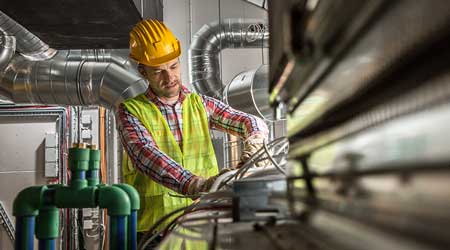
FM Perspectives: The Rockefeller University In the Eye of the COVID Storm
April 13, 2020
In the very early days of the COVID-19 outbreak, it seemed suddenly having to close down the university meant the facilities staff at The Rockefeller University in New York City might be able to catch up on some projects. But as the news rapidly evolved, and the urgency of strict social distancing measures was understood, all that came to a rapid halt, says Alex Kogan, associate vice president of plant operations and housing.
For this article, we spoke on March 31. The university had been closed since March 18. As of April 13, New York leads the country in known COVID-19 cases and deaths by a significant margin, with more than 180,000 cases.
Although the campus is shut down, there are more people still on campus than on a typical weekend, says Kogan. That is because 18 of the university's typically operating 75 labs are working on research to help the scientific community move towards a vaccine for COVID-19. In addition, the university's vivarium must still be staffed. And the university's residential buildings, adjacent to the campus, are still occupied. This means Kogan still has a robust staff reporting for duty, although on a rotating basis. "The morale is very good on our staff," Kogan says. "Everybody feels like they're doing their part to cure this thing."
Taking care of their own
The standard operating procedure is for everyone to assume everyone is a carrier, even if there are not visible symptoms. This has required strict protocols to be put in place, which Kogan says have been tightly adhered to.
"Maybe because we're a community of scientists, maybe they all understand the importance of this," he says. For example, in the residential space all playgrounds and community rooms have been shut down. Only one family unit can be in an elevator at a time. When a package arrives, door staff walk it to a table and the resident waits to approach the table until the door staff is at a safe distance.
On the facilities team, all work that requires more than one person has stopped. If the situation can not be remedied by one person, the team thinks of ways to mitigate the situation so that the repair can be deferred. For example, in one of the spaces there was an air conditioning leak high up, which would require more than one person to address since a tall ladder would be needed. To defer the situation, the valve feeding that zone was shut off. "We'll get back to it when it's safe to work in pairs," Kogan says.
In addition to precautions, the university is also taking care of its staff, including outsourced staff, by keeping them on the payroll. Outsourced food service and outsourced custodial teams are being paid during the closure, Kogan says, even though they have been asked to stay at home.
Working the plan
Kogan's team is known for being very well prepared to weather storms. Usually they are of the meteorological variety, but being a research university with priceless life-saving experiments on the line, being unprepared is not part of the vocabulary for the facilities team. The university's emergency preparedness committee, populated by key stakeholders from across disciplines, meets four times a year and ahead of any incoming threat. Kogan says to respond to COVID-19, the university's H1N1 plan has been the roadmap. Steps such as what to do if people couldn't go home, having inflatable beds available, and how to spread people out have all come into play. "Never in a million years did we think we'd have to put it in motion," Kogan says. "But the reality is really matching what we planned."
Of course, reality is always a little different than even the best-conceived tabletop. In real life, the logistics of safely getting materials onto and removed from campus has had to be figured out. Acquiring PPE has been another hurdle. The primary need is for medical professionals, of course, but at the same time some of the researchers need it, as well as frontline facilities personnel. For example, when a person in a residential apartment has a clogged bathroom, but is self-isolating, Kogan needs to still assure the safety of his staff while they address the situation.
Kogan says he hopes his colleagues in the industry are finding ways to shine a light on those essential members of their teams who are still coming in, keeping the plumbing in good order, or taking out the trash. "Somebody has to keep those ICU rooms running, keep the lights on, keep the power on," he says.
Naomi Millán is senior editor of Building Operating Management. What does the COVID-19 response look like from where you’re sitting? Send me an email sharing best practices you’ve discovered, surprising pivots you’ve had to make, or just general observations at naomi.millan@tradepress.com.
Next
Read next on FacilitiesNet












